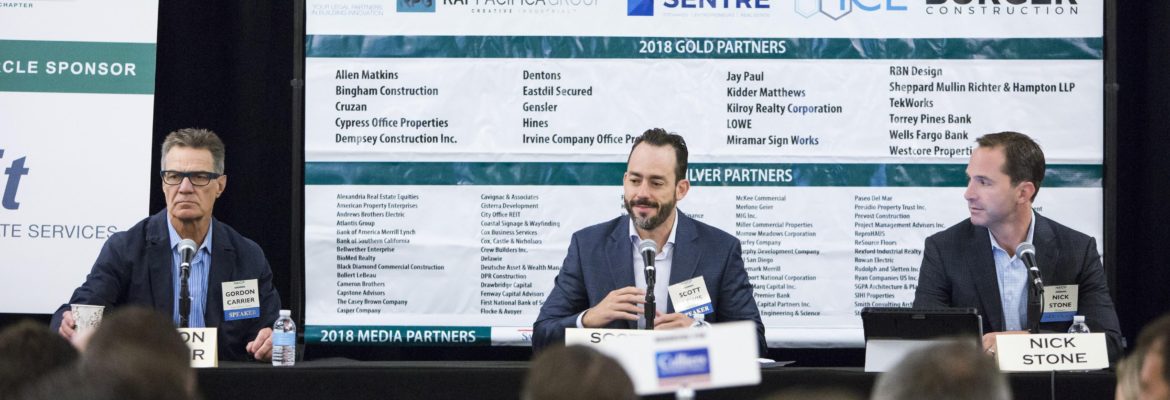As San Diego voters face a big decision about the direction of the SDCCU Stadium site in Mission Valley this November, NAIOP San Diego convened a panel discussion, moderated by Voice of San Diego’s Scott Lewis, to help its members and guests understand the two visions presented by SoccerCity and San Diego State University (SDSU).
Perspectives differed, as SoccerCity (Measure E on the ballot) was presented by SoccerCity Project Manager Nick Stone, while the SDSU West plan (Measure D on the ballot) was presented by SDSU’s architectural consultant for the project, Gordon Carrier, principal architect of Carrier Johnson + Culture.
Open space
According to Stone, the SoccerCity plan includes privately funding 60 acres of park space—committing $40 million to create a park that SoccerCity would maintain for 99 years.
Carrier told the audience the SDSU plan focuses first on resolving the site’s floodplain issues by creating upper and lower plains. Open space accounts for 52 percent of SDSU’s proposal, including 89-acres of park space. A proposed River Park would be owned by the City of San Diego but developed by SDSU with public input. SDSU’s plan also commits to a full California Environmental Quality Act (CEQA) review.
Housing
Both plans include affordable housing units, as per San Diego’s inclusionary housing plan. SoccerCity proposes 4,800 units of total housing. SDSU proposes building 4,600 units but anticipates much of the housing it develops to be occupied by SDSU faculty, staff and students.
Retail
Planned retail space represents one of the biggest divides between the two plans. SDSU expects to develop 95,000 square feet of retail space, whereas SoccerCity projects 700,000 square feet. SDSU maintains that 95,000-square-feet of retail space is more than enough to support the projected population and accounts for less projected car trips than would be incurred by the SoccerCity plan.
SoccerCity’s robust retail space would provide a strong tax base for San Diego, Stone said.
Office/Other Space
The SoccerCity plan includes 2.4 million square feet of office space. SDSU splits its remaining commercial space between 1.6 million square feet of office, research and educational space in a mix of private and public uses. It also includes a planned hotel and conference center that would be integrated with SDSU’s hospitality management degree program. Stone reminded the audience that the SoccerCity plan also sets aside 35 acres of expansion space for SDSU’s use.
Stadium
Currently, the stadium costs the City of San Diego $12 million annually to operate and maintain, with SDSU paying less than $1 million for playing its football games there.
Stone outlined SoccerCity’s vision of a new joint-use stadium for soccer and football that would feature games of the Major League Soccer team it plans to attract, with a sports and entertainment district surrounding it. If a team cannot be secured, the site will never transfer to SoccerCity. SDSU’s plan includes a financially self-sustaining, 35,000-seat stadium for football, soccer and concerts with the ability to expand it at either end to meet Major League Football requirements.
Financials
Stone said the SoccerCity plan would amount to $150 million of savings for San Diego. SoccerCity would ultimately pay $83 million—a sum he described as fair market value—for the site, purchasing up to 79 acres. Initially, however, the group would lease the site. He estimated $2.8 billion in fiscal impact from SoccerCity and 26,000 jobs created.
Carrier presented primarily from a design point of view, not as a financial representative, but he maintained that neither SDSU students nor taxpayers would finance SDSU West. He referenced SDSU’s 150 years of history, as well as the university’s $5.6 billion annual influence on San Diego and $457 million of state tax generated.
About NAIOP San Diego
NAIOP San Diego is a chapter of NAIOP, the Commercial Real Estate Development Association, and it comprises more than 750 members serving the local San Diego market. NAIOP is the leading organization for developers, owners and related professionals in office, industrial and mixed use/retail real estate, with 18,000 members in North America. NAIOP advances responsible commercial real estate development and advocates for effective public policy. For more information, visit www.naiopsd.org.

